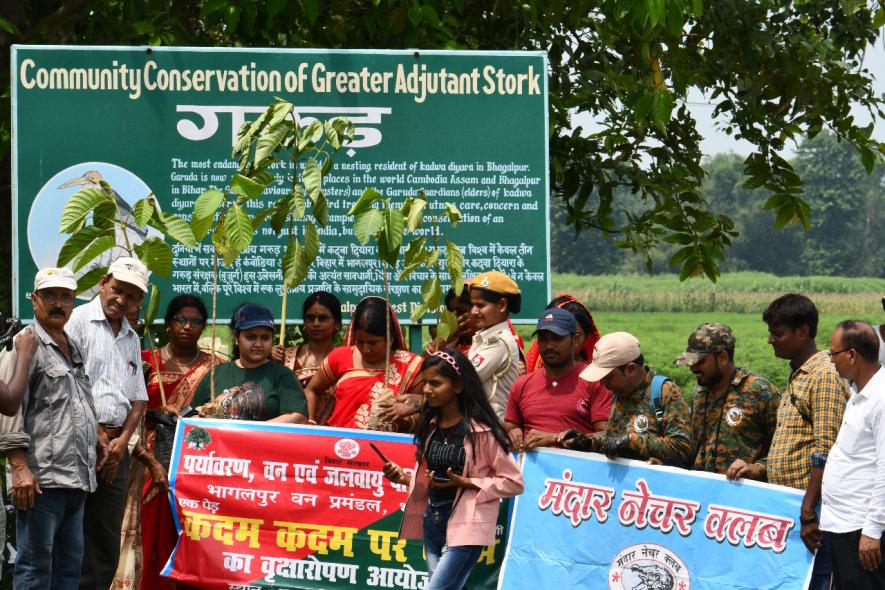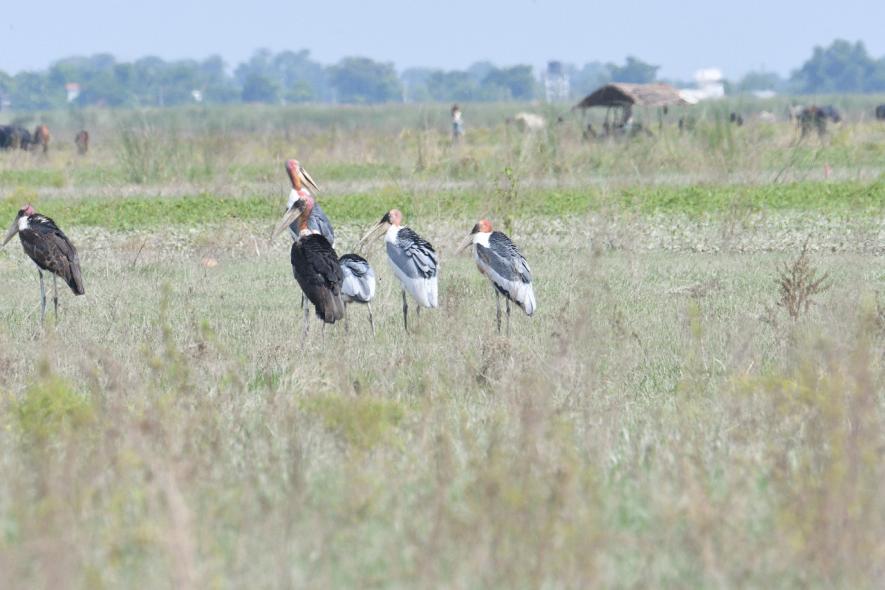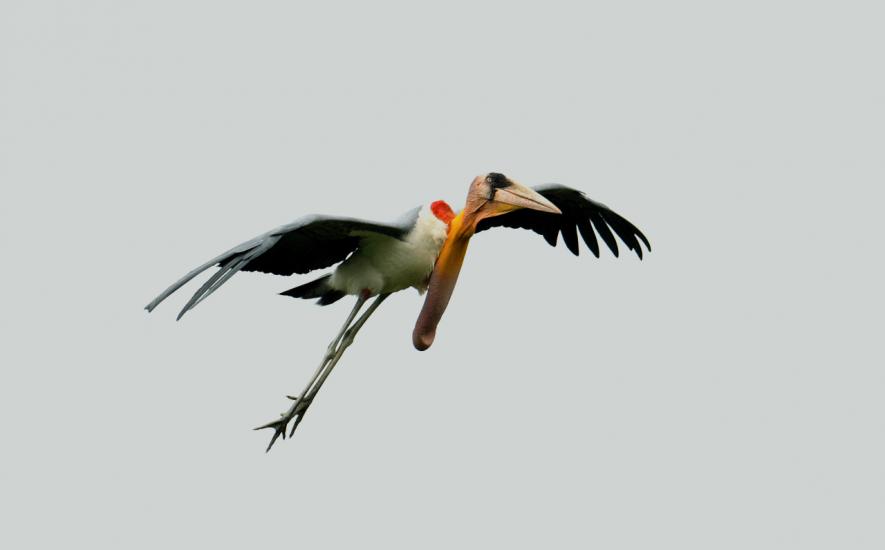Bihar: Endangered Greater Adjutant’s Breeding Ground Recognised as OECM

Patna: Kadwa Koshi Diara floodplains in Bihar’s Bhagalpur district, considered the third-most-popular breeding ground and habitat for the endangered Greater Adjutant stork in the world after Assam and Cambodia, have been included in the list of “Other Effective Area-based Conservation Measures” (OECMs). It has come as good news for ongoing efforts by the local community of the riverine belt to conserve greater adjutants, locally known as “Garuda”.
The greater adjutant stork is classified as ‘endangered on the International Union for Conservation of Nature (IUCN) Red List 2004 of threatened species and listed under Schedule IV of the Indian Wildlife (Protection) Act, 1972. This huge stork has a naked pink head, a very thick yellow bill and a low-hanging neck pouch. The neck ruff is white. The bird looks like a vulture. Other than the pale grey edge on each wing, the rest of its body is dark grey.

Juveniles have a narrower bill, thicker down on the head and neck, and entirely dark wings.. A Garuda bird measures 145-150 cm (about three feet) in length and four to five feet in height.
Besides Kadwa Koshi Diara floodplains, Jagatpur Lake in Bhagalpur, known for attracting more than 159 bird species, is another site declared an OECM.
Arvind Mishra, an expert on greater adjutants, who is also state coordinator of the Indian Bird Conservation Network (IBCN), told NewsClick that National Biodiversity Authority (NBA) had selected Kadwa Koshi Diara, known for a breeding ground of greater adjutants, as one of OECMs in the country.
”Kadwa Koshi Diara is declared an OECM for its biodiversity and conservation.”
Mishra, head of Bhagalpur-based Mandar Nature Club, said the Ministry of Environment, Forest and Climate Change, NBA and the United Nations Development Programme, along with other partners, was involved in identifying, mapping and reporting unique in-situ biodiversity conservation sites as OECMs in India.
VB Mathur, chairperson of NBA, in an official letter to Mishra, stated that the national biodiversity target aims to conserve areas of particular importance for biodiversity and ecosystem service through Protected Areas and OECMs.
The Convention on Biological Diversity (CBD) defines an OECM as a geographically defined area other than a Protected Area, which is governed and managed in ways that achieve positive and sustained long-term outcomes for the in situ conservation of biodiversity, with associated ecosystem functions and services and where applicable, cultural, spiritual, socio-economic, and other locally relevant values.
Mathur pointed out that recognition of an area as an OECM shall not affect the present legal status of the area but shall only be recorded in the World Database on OECMs.
Mishra said that UNDP, along with NBA, has been making a short film on new places selected as OECMs to present before the world for their conservation.
Ruchika Tripathi, project associate, UNDP Delhi, in a letter addressed to Mishra, said that India is one of the 17 megadiverse countries in the world. With only 2.4% of the world’s land area, India harbours 7-8% of all recorded species, including nearly 47,000 species of plants and over 1,00,000 species of animals.
"UNDP closely supports the Government of India in meeting national development objectives and commitments under key multilateral environment agreements by providing leadership support, fostering South-South cooperation and creating innovative partnerships with the public and private sector,"
She further added, “We are pleased to share that UNDP is developing a series of short films to document best practices from all over the country contributing to biodiversity conservation and ecosystem services. We are keen to cover Kadwa Kosi Floodplains and Jagatpur Lake, Bihar, as stellar examples of biodiversity conservation in India.”
Bhagalpur Divisional Forest Officer Bharat Chintapalli told NewsClick that OECM status to Kadwa Koshi Diara floodplains would boost the conservation of greater adjutants.
Mishra said in recent years, several surveys have found that the greater adjutant population has been slowly increasing, thanks to conservation efforts. The local community, mostly farmers, are working voluntarily to provide them with a safe and natural habitat.
Mishra, who first spotted greater adjutant and nesting and breeding in 2006-07 in the riverine in Bhagalpur, is also the man behind motivating the local community in two panchayats in Kadwa Diara to work for conservation.
He said the community conservation groups of local farmers, fishermen, youths, students and women are playing an important role in conservation that results in many fold increase in the population of the rare greater adjutant, their nesting or breeding numbers.
"There were 78 greater adjutants in 2007, which increased to more than 600 in 2022.“Their population will increase as much awaited nesting and breeding season of greater adjutant started in Kadwa Diara.“

The global population of the greater adjutant is estimated to be roughly not more than 1,800 now.
Mishra said the state government had extended full support to conserving the greater adjutant.
"A rescue and rehabilitation centre had been set up at Sundarban in Bhagalpur. It was a unique and, till now, the only such initiative in the country taken by the government. A temporary rescue provision had also been set up in the breeding zone for administering first aid to injured birds. When rescued birds recover, they are released into their natural habitat."
Get the latest reports & analysis with people's perspective on Protests, movements & deep analytical videos, discussions of the current affairs in your Telegram app. Subscribe to NewsClick's Telegram channel & get Real-Time updates on stories, as they get published on our website.
























